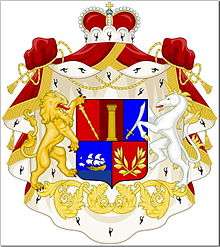House of Gurieli


The House of Gurieli (Georgian: გურიელი) was a Georgian princely (mtavari) family and a ruling dynasty (dukes) of the southwestern Georgian province of Guria, which was autonomous and later, for a few centuries, independent. A few ducal rulers of the dynasty also rose in the 17th-18th centuries to be kings of the whole western Caucasus in place of the hereditary Bagrationi kings of Imereti.
Bearing a hereditary title for governors (Eristavi) of Guria since the mid-13th century, Gurieli (literally, "of Guria") was adopted as a dynastic name by the Vardanisdze family (ვარდანისძე), hereditary rulers of Svaneti (a highland province in western Georgia). The other notable branch of the Vardanisdze was the Dadiani (დადიანი) of Samegrelo. Both of these branches occasionally used double names: Gurieli-Dadiani or Dadiani-Gurieli.[1]
The medieval Gurieli were vassals of the Georgian crown but, at the same time, seem to have paid some kind of homage (Greek: προςκυνησις) to the rulers of the neighboring Empire of Trebizond,[2] whose last emperor, David Komnenos (reigned from 1459 to 1461), is documented as having been 'gambros' of Mamia Vardanisdze-Gurieli (c. 1450 - 69), which is interpreted to mean that Mamia married his daughter or sister or close kinswoman. If the couple had issue, possibly the subsequent ruler Kakhaber (1469–83), the latter-day Gurieli would descend from several Byzantine and Trapezuntine emperors.[3]
In the 1460s, when the power of the Bagrationi Dynasty of Georgia was on the decline, the Gurieli pursued a policy of separation and became virtually (formally acknowledged at times) independent rulers (mtavari) of the Principality of Guria[4] in the mid-16th century,[5] but were forced to pay tribute to the Ottoman Empire, nominally recognizing also the authority of the princes of Mingrelia and kings of Imereti. Throughout the following two centuries, the politics of the Gurieli dynasty were dominated by conflicts with the neighboring Georgian rulers, Ottoman encroachment, and repeated occasions of civil strife and palace coups.
In the 17th and 18th centuries, as many as four Gurieli rulers managed to be chosen kings of the whole Western Caucasus in place of hereditary Bagrationi kings of Imereti. Gurieli kings however are usually characterized as usurpers, or as counter-monarchs of a rival dynasty.
On several occasions powerful neighbors also managed to divert the rule of Guria to members of rival branches of the Gurieli dynasty.
Having accepted Imperial Russian sovereignty in 1810, the dynasty continued to enjoy some autonomy in their home affairs until 1829, when the Russian authorities deposed Prince David, the last Gurieli, and annexed the Principality of Guria.[6] With the death of David in 1839, his cousin David Gurieli (1802–1856), and his descendants (Russian: Гуриели, Гуриеловы) were confirmed in the Russian nobility with the princely title of (knyaz) by the Emperor’s ukase of 1850.
Prince Gurieli Dynasty
- c. 1385–1410 – Kakhaber I; son of Giorgi II Dadiani; eristavi of Guria and Svaneti
- c. 1410–1430 – Giorgi I; son of Kakhaber I
- c. 1430–1450 – Mamia I; son of Giorgi I
- c. 1450–1469 – Mamia II; son of Liparit I Dadiani
- 1469–1483 – Kakhaber II; possibly son of Mamia II by his Trapezuntine wife
- 1483–1512 – Giorgi I (II); son of Kakhaber II; sovereign prince from 1491
- 1512–1534 – Mamia I (III); son of Giorgi I
- 1534–1564 – Rostom; son of Mamia I
- 1564–1583 – Giorgi II (III); son of Rostom; deposed
- 1583–1587 – Vakhtang I; son of Giorgi II
- 1587–1600 – Giorgi II (III); restored
- 1600–1625 – Mamia II (IV); son of Giorgi II
- 1625 – Svimon I; son of Mamia II; deposed, died after 1672
- 1625–1658 – Kaikhosro I (III); son of Vakhtang I
- 1659–1668 – Demetre; son of Svimon I; deposed, died 1668
- 1669–1684 – Giorgi III (IV); son of Kaikhosro I
- 1685–1689 – Kaikhosro II (IV); son of Giorgi III
- Malak'ia; son of Kaikhosro I; rival prince 1685; deposed
- 1689–1712 – Mamia III (V); son of Giorgi III; deposed
- Malak'ia; restored as rival prince 1689; deposed, died after 1689
- 1712 – Girogi IV (V); son of Mamia III; deposed
- 1712–1714 – Mamia III (V); restored
- 1714–1716 – Giorgi IV (V); restored; deposed
- 1716 – Kaikhosro III (V); son of Mamia III; deposed, died after 1716
- 1716–1726 – Giorgi IV (V); restored
- 1726–1744 – Mamia IV (VI); son of Giorgi IV; deposed, died 1778
- 1744 – Giorgi V (VI); son of Giorgi IV; abdicated, died after 1744
- 1744–1792 – Svimon II; son of Giorgi V; deposed
- 1778–c. 1780 – Kaikhosro IV (VI); son of Giorgi V; abdicated, died after 1820
- c. 1780–1792 – Svimon II; restored
- 1792–1803 – Vakhtang II; son of Giorgi V; deposed, died after 1814
- 1803–1826 – Mamia V (VII); son of Svimon II
- Kaikhosro, brother of Svimon II, regent 1803-1809
- 1826–1829 – Davit’; son of Mamia V; deposed, died 1839
- Sophia, mother of Davit’, regent 1826-1829
References
- ↑ (Georgian) ქ. ჩხატარაიშვილი (K. Chkhataraishvili) "გურიელები" (The Gurieli), in: ქართული საბჭოთა ენციკლოპედია (Encyclopaedia Georgiana). Vol. 3: p. 314. Tbilisi, 1978.
- ↑ (Russian) Михаил Панарет. Трапезунтская хроника (Michael Panaretos. The Trapezuntine Chronicles) "Труды по востоковедению" изд. Лазаревским институтом восточных языков (Lazarev Institute of Oriental Languages). М. 1905. Commentaries by Alexander Khakhanov. Accessed on April 8, 2007.
- ↑ Christopher Buyers, March - September 2003. The Gurieli Dynasty. Royal Ark: Georgia. Accessed on April 8, 2007.
- ↑ The early modern foreign sources frequently referred to the Principality of Guria as Guriel after its ruling dynasty.
- ↑ Suny, Ronald Grigor (1994), The Making of the Georgian Nation: 2nd edition, p. 45. Indiana University Press, ISBN 978-0-253-20915-3.
- ↑ Lang, David M. (1957), The Last Years of the Georgian Monarchy: 1658-1832, p. 52. New York City: Columbia University Press.